Parking Rules and Safety
Offences of Australia Road Rules formulated by the Road Traffic Act 1961 include:
NO STOPPING: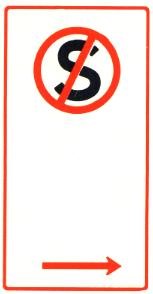
The NO STOPPING symbol means you are not permitted to stop unless traffic conditions require it (e.g. in a queue of traffic). These zones are created for road safety.
NOTE: The Supreme Court of South Australia has decided that driving a vehicle backwards and forwards in a No Stopping Zone while waiting (e.g. to pick up a passenger) amounts to “STOPPING”.
NO PARKING: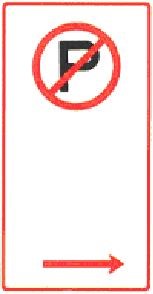
The NO PARKING symbol means you may stop for a maximum of two minutes. The driver must be in attendance and not more than three metres from the vehicle.
Some No Parking signs do not apply for certain vehicles (e.g. emergency services). In these cases the excepted vehicles may stop for an unlimited period.
BUS ZONE: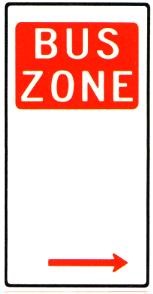
A vehicle must not park in a BUS ZONE within the Copper Coast Council unless the vehicle is a public bus.
NOTE: “Public Bus” is a bus engaged in regular passenger services under Passenger Transport Act 1994.
LOADING ZONE: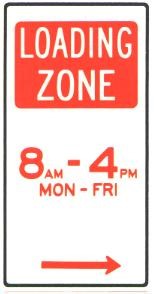
A vehicle must not be parked in a LOADING ZONE unless:-
- The vehicle is a Commercial Vehicle that is dropping off or picking up goods and the vehicle is parked for no longer than such time as is necessary to complete the loading or unloading (but in any event for no longer than 30 minutes);
- In the case of any other vehicle:- the vehicle is dropping off or picking up goods that are difficult to handle because of weight or size and the vehicle is parked for no longer than such time indicated on the signs;
- The vehicle is a public bus that is dropping off or picking up passengers;
- The vehicle is a taxi dropping off or (having been hailed or summoned for that purpose) picking up passengers, provided the driver does not leave the taxi unattended (i.e. the driver leaves the taxi and is over 3 metres from the nearest point of the taxi).
NOTE: “Commercial Vehicle” means a motor vehicle constructed solely or mainly for the carriage of goods and includes vehicles such as a utility, truck and van but does not include vehicles such as a station wagon, sedan, hatch, four wheel drive or coupe.
The times that Loading Zones operate are similar to Parking Zones, i.e. they may cease to operate during off-peak traffic periods. Here are some examples of vehicles which are entitled to be parked for a maximum of 30 minutes in Loading Zones.
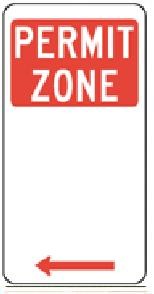 PERMIT ZONE:
PERMIT ZONE:
This area is only for vehicles correctly displaying a valid permit issued or recognised by the Council for that zone. NOTE: Holders of a disabled person’s permit are NOT entitled to park in a Permit Zone unless the sign is accompanied by a disabled person’s symbol.
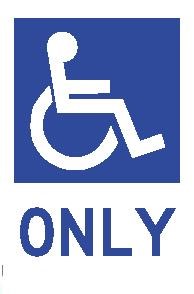
DISABLED SYMBOL:
The DISABLED PERSON’S symbol is also displayed in car parks and means that only vehicles displaying a current Disabled Person’s parking Permit issued under Part 3D of Motor Vehicles Act 1959 and driven by or carrying the disabled person may use the parking space.
NOTE: The holder of a Disabled Person’s parking Permit must comply with all parking conditions. Where a concession applies, it is referred to in the appropriate section of this guide.
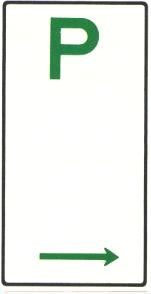
PERMISSIVE PARKING ZONE:
The PERMISSIVE PARKING sign allows you to park a vehicle as long as you obey any restrictions on the sign.
The 'P' symbol alone means there is no time limit in that Permissive Parking Area.
NOTE: The letter 'P' symbol may however be used in off-street car parks where a specified time or other conditions apply.
TIME LIMIT PARKING ZONE: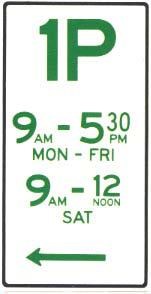
A TIME LIMIT may be stated on Permissive Parking signs. This enables anyone to use the available parking space for a set period instead of one vehicle parking for a maximum period of 24 hours (all day). The limited time is shown by a number beside the letter 'P' symbol (e.g. ‘1P’ means one hour parking; ½'P' means half hour parking). Where the limit is very short (e.g. 10 minutes) the word MINUTE is shown with the number.
Holders of a Disabled Person’s parking Permit are allowed certain concessions. If the time limit on the parking sign is less than 30 minutes, the time limit for a disability parking permit holder will be 30 minutes; or if the time limit on the sign is 30 minutes or more but 1 hour or less, the time limit for a disability parking permit holder will be two hours; or if the time limit on the sign is more than 1 hour, the time limit for a disability is double the period indicated.
TEMPORARY PARKING CONTROL: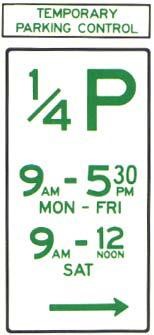
These signs are used when temporary conditions are necessary (e.g. parades or roadworks). These signs will override any other signs in the area. No changes to any existing road markings occurs.
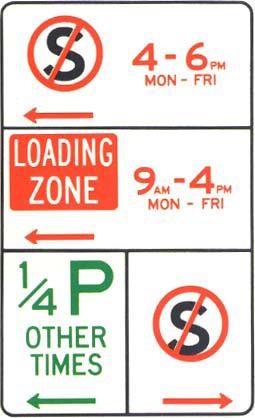
MULTIPLE SIGNS:
State different restrictions or conditions which apply at certain times during the week. All restrictions or conditions are located on the same panel. Each section must be read in conjunction with the other sections.
NOTE: Occasionally sign posted zones are interrupted by driveways, entrances, laneways or fire hydrants/plugs. Additional signs or road markings are not required under the legislation and are only installed if the zone is of sufficient length to warrant their placement. Motorists have a responsibility when parking to check for these items as well as any restrictions or conditions on both parking control signs and/or road markings that apply to the zone.
Parking Time Limits
Be sure to check parking restrictions and observe time limits to avoid a parking expiation fine.
Time limits are set to allow as many people as possible to have access to parking in high demand areas, providing an equal opportunity to all users.
All business districts have certain areas for all-day parking within walking distance.
Council staff are authorised to issue expiation notices in accordance with the requirements of relevant legislations.
Under Section 174AB of the Road Traffic Act, it states:
(1) An authorised officer may place an erasable mark on a tyre of a vehicle in the course of enforcing laws relating to the parking of vehicles.
(2) A person must not, without proper authority, erase a mark made under subsection (1).
Maximum penalty: $750.
Disabled Parking
In most car parks and some streets, parking areas are reserved for holders of disabled permits only.
If you hold a current disabled parking permit, you are entitled to park in the disabled parks.
The disabled parking permit must be displayed in the motor vehicle at all times.
Council Officers can enforce all disabled parks in the Copper Coast, including private car parks.
Parking Around Schools
At the majority of the schools within the Copper Coast, there are 'No Stopping' areas and/or parking restrictions.
Before and after school 'drop-offs' are a busy time on the roads with many children walking, riding and being dropped off by car to get to school. Young children are particularly vulnerable and so we all need to remain alert and take precautions around schools and adhere to parking restrictions.
If you as a driver park in these areas, which for some are restricted due to blind spots and/or a hazard for children, you may be the cause of an accident.
Council regularly receives complaints and requests from schools and nearby neighbours with parking and accessibility around schools due to the increased traffic during short-specific periods. Council is not responsible for providing parking around schools but has the difficult task of managing the limited number of on-street spaces available.
For this reason, parking restrictions are installed around school vicinities to support the many people dropping off and collecting children during peak periods including No Stopping, Yellow Edge Lines and No Parking restrictions.
Council, in conjunction with schools and local police, aim to ensure the safety of children at all times, and this may result in the necessary enforcement of the parking restrictions.
Children Crossings
Keep Kids Safe - A Guide to Traffic Safety Around Schools
Stopping your vehicle too close to a Children's Crossing may mean that a child entering the crossing can't see or be seen by an approaching car.
When a Children's Crossing is in operation you must not stop:
within 20 metres before the crossing
within 10 metres after the crossing
Stopping momentarily to let a child out or pick a child up is an offence. However, if there is also a No Stopping sign at the approach to the crossing you must obey it at all times
School Zones
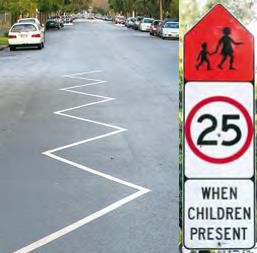 School zones are installed on most roads around schools - as shown by these signs. A zigzag white line is also usually marked on the road to let drivers know they are approaching a School Zone.
School zones are installed on most roads around schools - as shown by these signs. A zigzag white line is also usually marked on the road to let drivers know they are approaching a School Zone.
Drivers must not exceed 25km/h at any time of the day or night when a child is in the zone. This includes children walking or riding a bicycle either on the road, footpath or median strip.
The lower speed limit applies whenever children are in the zone, including weekends and school holidays.
It makes sense to slow down as you approach a school at all times of the day and night to check if there are children in the area. Children can be present outside of normal school hours because of many activities that take place in the school.
Emu Crossings
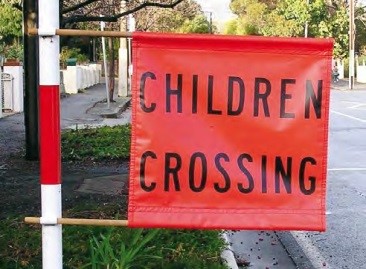 An Emu Crossing has a red ‘Children Crossing’ flag displayed on red and white striped posts. When the flags are displayed, drivers must give way to pedestrians crossing or about to cross the road.
An Emu Crossing has a red ‘Children Crossing’ flag displayed on red and white striped posts. When the flags are displayed, drivers must give way to pedestrians crossing or about to cross the road.
Emu crossings are located within School Zones have a speed limit of 25km/h when children are on the road or footpath.
The 25km/h school zone speed limit still applies if the ‘Children Crossing’ flags are not up and children are present.
Koala Crossings
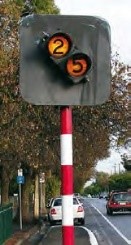 A Koala Crossing consists of two yellow flashing lights mounted on red and white striped poles.
A Koala Crossing consists of two yellow flashing lights mounted on red and white striped poles.
Koala Crossings operate only when the yellow lights are flashing. A 25km/h speed limit applies between signs on the approaches to the crossing when the lights are flashing, and drivers must stop and give way to anyone using the crossing or about to cross the road.
School monitors may be present at the crossings and it is important to obey the Stop signs used by the monitors.
Wombat Crossings
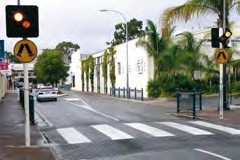 A Wombat Crossing consists of a wide road hump marked with thick white stripes.
A Wombat Crossing consists of a wide road hump marked with thick white stripes.
A 40km/h speed limit applies at all times within 30-40 meters of the crossing as shown on signs.
When a pedestrian is crossing or about to cross the road, drivers must stop and give way.
Double Parking
It is illegal to 'double park' (eg car parking next to another car that is parked along the road verge).
Council is mindful of congestion around schools and reports vehicles for this offence when a passenger enters or leaves the vehicle while it is 'double parked'.
No Stopping Zone and Continuous Yellow Edge Line
A No Stopping Zone and a Continuous Yellow Edge Line (running parallel to the kerb) prohibits any parking or short term pausing (with the motor still running) to let a children in/out for pedestrian safety reasons and to maintain access.
No Parking
A No Parking zone means that you can not park and leave your vehicle; or stop for more than two minutes in the No Parking area to drop off or collect passengers or goods.
Intersections
Parking your vehicle too close to an intersection endangers pedestrians and other drivers, by blocking their view of the traffic and restricting other drivers' turning area.
- A driver must not stop on a road within twenty (20) metres of the nearest point of an intersecting road at an intersection with traffic lights.
- A driver must not stop on a road within ten (10) metres from the nearest point of an intersecting road at an intersection without traffic lights.
Parallel Parking
All vehicles must be parked parallel to the kerb unless the signs and or road markings indicate angle parking is required.
All parallel parked vehicles must face the same direction as the moving traffic on that side of the road. This is called 'the lawful direction'. To ensure a clear passage for moving traffic, parallel parked vehicles (other than motor cycles) must have both kerbside wheels as close as practicable to the kerb.
Stopping Across Driveways
No vehicle is allowed to obstruct their own or another person's driveway. This includes being close to the driveway that prevents a vehicle from driving in or out.
Parking on Footpath, Reserves and Dividing or Nature Strip
Driving or parking on a reserve, dividing strip, footpath, footway or verge or entering back into the flow of traffic from one of these is prohibited.
Aside from the obstruction of pedestrian movement, footpaths are not designed to bear the weight of vehicles and parking on a footpath could caused damage to the surface materials and services located underneath.
A footpath is the area from the kerb to the property boundary, this includes lawns and gardens. This includes the grass verge outside your home, lanes and other places made or constructed for the purpose for pedestrian use only. The section of footpath, which enables access to premises, is also part of the footpath and is not available for parking.
Bike Lanes
Many of the main roads in our region have lanes which are provided specifically for bicycle riders. There is signage at the beginning of the lane, along the length of the lane and at the end.
Bike lanes are a single roadside lane indicated by a solid white continuous road marking. The bicycle symbol is painted on the road on intersections, which form part of the bike lane.
Bike lanes are a State Government initiative with the aim to provide a legitimate and reasonably unimpeded road area for cyclists and to improve road safety.
It is an offence for a vehicle to be parked with any part of that vehicle in a bicycle lane during the times specified on the bike lane sign. If there are no times indicated on the sign, the bike lane is in operation 24 hours.
You must not stop in a bike lane at all regardless of your reasons to do so. This is considered a serious offence and a severe penalty applies.
Clearways
Clearways are intended to improve traffic flow during the peak periods.
A clearway starts at the 'Clearway' sign and ends at the 'End Clearway' sign. You cannot stop your car between these signs during the times specified on the clearway sign.
Stopping Near a Fire Hydrant
A driver must not stop within one (1) metre of a fire hydrant, fire hydrant indicator or fire plug indicator.
Loading Zones
Loading Zones are only available for the pick-up or set-down of goods or items, which are too large or heavy to carry conveniently. If you have a commercial vehicle you may use a Loading Zone for a maximum of thirty (30) minutes as long as you are loading or unloading. A 'commercial vehicle' means a motor vehicle constructed solely or mainly for the carriage of goods (including a vehicle of the kind commonly called a utility, but excluding a vehicle of the kind commonly called a station wagon or station sedan).
All other vehicles (this includes station wagons and hatchbacks) may only use a Loading Zone for a maximum of 10 minutes if goods, which due to their weight or size are difficult to handle, are being picked up or set down.
Heavy Vehicle Parking
Under the Australian Road Rules 1999, vehicles over 7.5 metres in length (including a trailer attached) or having a gross vehicle mass (GVM) of 4.5 tonnes or over, can only be parked on a road for a maximum of one hour.
Owners or drivers of a vehicle of 3 tonnes or over, wishing to park on a residential property require Development consent. The type of vehicle which need consent include: buses, motor homes, vans, trucks, prime movers, earth moving equipment and associated trailers. Please refer to web page Planning and Development for further information.
Frequently Asked Questions
1. Can I park on a path, Dividing Strip or Nature Strip?
No. Vehicles must not be parked with any part of the vehicle on a footpath or footway. This includes the grass verge outside your home. Apart from the obstruction of pedestrians, footpaths/footways are not intended to bear the weight of vehicles as damage may be caused to curbing, the land surface or services located underneath.
2. If I’m in a Parking Zone with a time limit can I move the car to a nearby parking space when the time expires so I can stay longer?
Yes, but ONLY if the vehicle has first been removed completely from its current parking area.
3. Can I park my semi-trailer in the street all day?
No. A long vehicle (including a car with a caravan or trailer attached) that exceeds 7.5 metres in overall length can be parked for no longer than one hour, day or night, in unrestricted parking areas unless loading or unloading is taking place. Note: Long vehicles are bound by normal time restrictions in zoned areas.
4. Am I parallel parked legally as long as the wheels of my vehicle are inside the line markings on the road?
No. No part of the vehicle must overhang the line marked parking bay.
5. When can I park my car in a Bus Zone?
Never. Not even for the purpose of the immediate setting down or picking up of a passenger.
6. I am the owner of a Range Rover. I wish to collect a personal computer terminal from a local business. How long am I allowed to park in the nearest Loading Zone?
A vehicle of the Range Rover type is a vehicle classed as a station wagon or station sedan and is excluded from the definitions of a “Commercial Vehicle” under the legislation. The maximum time such a vehicle may remain in a Loading Zone is for no longer than such time as is necessary to complete the dropping off or picking up of goods that are difficult to handle because of weight or size.
7. My vehicle is registered as a Bus. I understand I can leave it parked in a Bus Zone while I grab a cup of coffee?
Wrong. Only a Public Bus and other specially licensed vehicles under the Road Traffic Act 1961 engaged in scheduled services may park in a Bus Zone. See the comments under the Bus Zone section.
8. I was sitting in my car with the engine running in a Loading Zone waiting to pick up my wife and her shopping. I was furious to get a parking ticket. Surely the Parking Officer had no right to book me in these circumstances?
The Parking Officer correctly reported your vehicle. Waiting in a non commercial vehicle is not permitted in a Loading Zone.
9. I parked in a Ticket Parking area. I had a valid ticket displayed on the driver’s side of the dashboard of my car. When I returned to the vehicle I saw a Parking Officer issuing an Infringement Notice. I asked him why and he said he could not read the ticket from the passenger’s side of the vehicle. I accept it may have been difficult to read, but did he have the right to book me?
Yes. The ticket must be displayed as per the rear of the ticket and in such a position that it is easily readable to anyone standing alongside the vehicle.
10. I parked my motorcycle well within the road markings of a parking bay in a Parking Zone. There was plenty of room for my bike even though a small car was already parked in the bay. Is it alright to do this?
No. Only one vehicle is permitted to park in an individual parking bay, regardless of size. However, more than one motorcycle is permitted to park in a car parking bay providing there is no car already parked there, and each motorcycle must have one wheel as close as possible to the kerb
11. I own a removal business and use a truck over 7.5 metres in length. How long can I park in:-
- A Loading Zone - 15 or 30minutes.
- A Parking Area with a time limit- One Hour
- A Parking Area without a time limit - One Hour
12. I sometimes attach my trailer to my vehicle for various purposes when I drive into town. Together the car and trailer are over 7.5 metres in length. Does this make my car a “Long Vehicle” for the purpose of the legislation?
Yes.
13. If I park my vehicle and trailer in a Loading Zone how long am I allowed to have to load/unload under the Australian Road Rules?
There are no special provisions for non commercial vehicles with trailers attached that entitles them to be parked in Loading Zones.
That being said, if the towing vehicle is a Commercial Vehicle the maximum time is 30 minutes.
14. My vehicle is a Long Vehicle (i.e. over 7.5 metres in length). How long can I park in an angle Parking Zone?
You can not park your vehicle in angle parking bays and as the driver of the vehicle you should find alternative parallel parking options.
15. My vehicle is a long vehicle. Am I allowed to parallel park in a Parking Zone and use more than one space?
Yes. But only where parallel parking is permitted and you must occupy the least number of bays as possible.
16. I had friends to stay at the weekend. As I have car space for one vehicle only on my property, I allowed my friends to park their car on the road across the entrance to my property. As I gave them permission to obstruct my entrance, could their vehicle still be booked?
Yes. No one including the property owner is permitted to block access to a driveway.
17. I parked in a 15 minute Parking Zone to collect a prescription from my doctor. I was delayed and did not return for over 45 minutes. I was horrified to see I had been given 3 Infringement Notices. One for exceeding the time limit and 2 for further offences. Was the Parking Officer right in booking me that way?
Yes. It is the driver’s responsibility to park in an appropriate place and to allow sufficient time even if their business is delayed. Further offences occur when a vehicle remains parked for successive periods of time that equal the time limit for the zone in which the vehicle is parked.
18. My car is a utility. I understand I can park in a Parking Area where vehicle bays are marked out even if my load is overhanging the space?
Wrong. The Australian Road Rules provide the total width/length of a vehicle (including the load) must be completely within the confines of the parking bay or space.
19. I double parked for a few seconds while I dropped off my wife. I saw a Parking Inspector and wondered if he could have booked me as I drove off before he could fasten an infringement notice on my car?
Yes -There is no requirement under the Australian Road Rules 1999, for an Officer to place an Infringement notice on a vehicle and the notice can be posted to the registered owner or driver.
20. I have received a “Reminder Notice” from the Council in respect of a parking infringement which tells me I can complete a statutory declaration if my car was being driven by someone else at the time of the offence. Several people drive my car and I can’t remember who was driving at the time. If I tell the Council I don’t know who was driving, can they still prosecute me?
Yes. The owner of the vehicle may be legally responsible for the Parking Infringements unless he or she provides the full name and address of the driver at the time.
21. I used to own a Datsun 120Y, but sold it over a year ago through an advertisement in the paper. I didn’t bother to retain the part of the vehicle transfer form headed “Disposal Notice” and realise now I broke the law by not doing so. In fact I signed the form and just handed the papers to the buyer. I figured it was his car now and he said he would see to the formalities of the transfer at the Motor Registration Division. Three months later I started getting a whole series of parking infringement notices. I rang the Council to find out what was going on and they said I was still the registered owner of the vehicle. What do I do now?
(1) Provide a statutory declaration to the Council immediately giving the full name and address of the buyer of the vehicle together with a copy of any sale notice to back up your claim.
NOTE: If you do not provide a statutory declaration within 21 days of receiving the “Reminder Notice” from the Council or provide proof of sale, you may be held responsible for the parking infringements as “the owner” of the vehicle.
(2) You should also approach Transport SA to resolve the situation concerning ownership of the vehicle.
23. My vehicle broke down and I had to leave it in a No Stopping Zone. What should I do to avoid getting infringement notices?
If your vehicle is disabled in a No Stopping Zone, immediate action must be taken to resolve the situation by seeking assistance or arranging for the vehicle to be towed away. You should always leave a note in a prominent position on the passenger side of the vehicle (i.e. side nearest the kerb) and ring the Council. If you do receive an infringement notice you will be required to produce documentary evidence (e.g. a letter from the RAA or similar service provider confirming that the vehicle was in fact broken down).
24. My child had a seizure and I had to rush her to the Hospital. There was nowhere to park and I had to leave the vehicle partially in a No Stopping Zone. When I came out I had received an infringement notice. What should I do?
Obtain a statement from the Hospital in support of your claim that it was an emergency situation and send it immediately to Copper Coast Council quoting the notice number of the infringement notice and/or your vehicle registration details.
26. I am a tradesperson working in the township and parked in a loading zone can I park for longer than the period allowed?
Trades people cannot park for longer than the period allowed in a Loading Zone, however, when they have active work to be completed in the township, they may request a temporary parking permit to park in a time limit or ticket parking area for a specified time by phoning the Copper Coast Council on 8828 1200 to arrange a permit. Extensions are granted on a case-by-case basis having regard for congestion in the area requested and any other alternatives that may be available.
27. Can I park in my driveway, even though it blocks the footpath / Verge?
No. That part of the driveway must be clear at all times for the safety of pedestrians.

